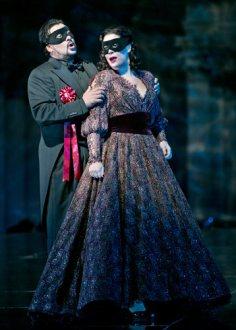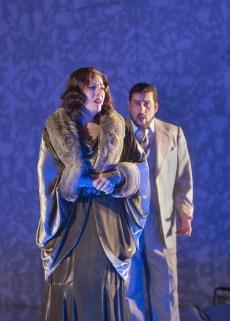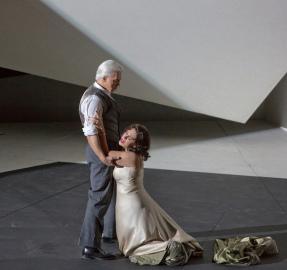
Marcelo Alvarez & Sondra Radvanovky (Sarah Krulwich/The NY Times)
Last Saturday, December 8, was the first broadcast of the new Metropolitan Opera radio season. It was of composer Giuseppe Verdi’s Un Ballo in Maschera (“A Masked Ball”) in a new production directed by David Alden. It was good to have the Met Opera back on the air I have to say, after a long, hot summer and a tediously unproductive fall.
I’ve been listening to the Met broadcasts since (yikes!) 1965-66, and regularly after the 1967-68 season. The first opera I heard was Aida, also by Verdi and scheduled for airing this coming Saturday, December 15. I was very young at the time, but I can still remember the names of the individual cast members, including American soprano Leontyne Price as Aida, tenor James McCracken as Radames, and baritone Robert (“Oh, say, can you see”) Merrill as Amonasro. I can’t tell you any more about the performance without consulting the Met Opera’s archives, but I do recall taping most of Act II for later playback, so I guess it wasn’t a total loss.
But this post is more about the current scene, so let’s get back to Ballo, one of the Italian master’s finest and most intricately detailed works. Composed between 1857 and 1859, Un Ballo in Maschera is a transitional piece that came just after his so-called middle period (1851-1853), a time that produced three of his most popular operas, i.e., Rigoletto, Il Trovatore, and La Traviata. It shares similar thematic material with Rigoletto, in the basic plot of an assassination attempt on its tenor lead; and looks forward to the Judgment Scene in Aida (1871), particularly the heavy use of brass, which adds considerable weight to the conflicts that take place between the main characters. There are nods to the future Otello (1887), too, in the Third Act drawing of names sequence with its sonic echoes of Otello’s farewell to arms speech (“Ora e per sempre addio”) and the Vengeance Duet that closes Act II of that work.
Verdi wrote Ballo on commission for the theater in Naples. He chose as his subject the assassination of King Gustav III of Sweden, which took place there in 1792. However, due to the sensitive nature of the story, highlighted by the actual onstage murder of a royal figure, the Neapolitan censors refused to stage it unless drastic changes were made. An old hand at dealing with bureaucratic stonewalling (especially after the modifications to Rigoletto’s plot and characters), Verdi directed his first-time librettist, Antonio Somma, to comply with the censors’ demands. Somma did as he was told and the original title of Gustavo III was changed to Una Vendetta in Domino (“A Revenge in Costume”).
Still not satisfied with the results, the censors called for even more cuts and alterations, no doubt spurred by a terrorist’s bomb hurled at French emperor Napoleon III’s carriage. Both Verdi and Somma were thoroughly dismayed by the actions demanded of them and subsequently withdrew the work. A short while later, after further adjustments to the story, which transformed King Gustav into the fictitious Riccardo, governor of colonial Boston, and placed the opera in pre-Revolutionary War times (!), they offered the re-worked and re-titled Un Ballo in Maschera to the Teatro Apollo in Rome, where it met with sizable success.

Sondra Radvanovsky & Marcelo Alvarez (Ken Howard)
There were other incongruities involved in this new context as well, the most noteworthy being the character of King Gustav (now Riccardo) himself. An extravagant individual and patron of the arts, the historical Swedish king was an admitted Freemason as well as rumored to be of a homosexual bent, although this has never been proven. That did not stop Verdi from giving him a love interest, Amelia, the wife of his would-be assassin Count Anckarström. In the Boston scenario, Amelia remained Amelia, but the Count had his name changed to Renato, the conspirators Horn and Ribbing were now called (don’t laugh) Sam and Tom, Oscar the page stayed Oscar the page, and Ulrica the mysterious Medium became Ulrica the Witch (a soothsayer or prophetess, either one was acceptable). The work has since been performed in both its Swedish and American locales, while the Met uses the original Swedish one for its current production.
In the opera proper (and in the history books), the murder of the king occurs at the Royal Opera House in Stockholm, where the titular masked ball takes place. It’s this scene – the final one in the opera – that most resembles its predecessor Rigoletto, although everything about Ballo has an orderly flow and logical connection to the earlier work. The music here is bouncy and bright, full of ironic contrasts and startling juxtapositions, and done by the simplest of means: a minuet serves as the musical backdrop to the king’s murder, thus increasing the tension almost to the breaking point. Compare it to Rigoletto’s opening scene in Act I, which is equally light and airy, but with nary a hint of the darkness to come.
Enter Oscar, the king’s lighthearted page, voiced by a coloratura in boy’s clothing, what is often termed as a “trouser” role. Verdi fashioned this character after the page Urbain in Meyerbeer’s Les Huguenots, but he clearly takes after the adolescent Cherubino of Mozart’s The Marriage of Figaro. Needless to say, Oscar’s music is the main attraction in Ballo, and the most titillating Verdi ever wrote: at once charming and carefree, full of youthful vigor and warmth, the master would not compose themes of this flavor and wit until his very last work, the comic Falstaff, some 44 years later.
The story, in brief, involves King Gustav’s affair with the married wife of his chief counselor and friend, Anckarström, who hatches a plot to kill the king after he catches his spouse in an illicit encounter with the monarch. The role of both King Gustav and his friend are plum parts for tenor and baritone, as are the other roles of Amelia, Oscar and Ulrica.
Now on to the review: Marcelo Alvarez did well as Gustavo. The Argentine tenor has a real feel for the words, and his lyric singing – the opening “La rivedra nell’ estasi,” for example – was exceptionally heartfelt and exquisitely phrased. However, he does not like to linger on high notes (unlike the late Luciano Pavarotti, who relished every aspect of this part). Elsewhere, Alvarez refused to dawdle. The attitude was, let’s get this show on the road, which was fine by me (and no doubt the conductor’s choice).
Unfortunately, he ducked the high C in the great second-act duet with Amelia, sung by the excellent Sondra Radvanovsky – what’s with that? Pavarotti was known to have thrust his face (and prickly beard) into the back of his female lead’s hair at this point, but he still managed to get that C-note out. In Sir Georg Solti’s first recording of the work, Carlo Bergonzi was all-but overwhelmed by the Wagnerian Birgit Nilsson, but he still made it to C (or tried to, albeit in drowned-out form). As I recall, Marcelo sang the note in Tosca’s Act III duet with Karita Mattila, so I was a little surprised by the occurrence. He did deliver a ravishing last act lament, though, so reminiscent of Otello’s death scene, with the final word cut off just as Gustavo expires – a nice touch, that.
How like the Duke of Mantua the king is, but without that character’s insouciance and self-centered egotism. A truly rewarding role for any tenor to tackle, which Alvarez could have made more of than he likely did. His “È scherzo od è follia,” Gustavo’s mocking reaction to Ulrica’s prophecy that the next person to shake the king’s hand would be his assassin, lacked the customary “laughs” and “giggles,” a practice started by Beniamino Gigli. Perhaps Alvarez was going for a more straightforward approach. Not that the scene was badly sung, it just missed that final spark of “fun” that would have truly ignited his performance.
Sondra Radvanovsky’s Amelia was sublime, the only word that comes to mind when talking about this marvelous artist. Sondra has done magnificent work in Verdi and Puccini before, but in Ballo she really outdid herself. All the emotional impact and dramatic thrust this role can have on an audience were there in spades. Mind you, Amelia is not the most gratifying of soprano roles – she makes a brief appearance in Act I, in a remarkable trio with Ulrica and the disguised king. But she really comes into her own in Act II, where she is onstage throughout. Act III starts off with her pathetic farewell to her son, “Morrò, ma prima in grazia,” which earned Sondra a huge round of applause at its close. Brava!

Dmitri Hvorostovsky & Sondra (Ken Howard)
The Anckarström was Siberian baritone Dmitri Hvorostovsky, in good, solid voice but in my opinion he took an inordinately long time to warm up. He may have been under the weather, but Dmitri picked up steam in Act III during “Eri tu?” This aria stands as a carbon copy of Rigoletto’s great scena, “Cortigiani, vil razza dannata,” from Act II of that opera, they’re so strikingly similar (in musical terms, that is, not textually), especially in the way both pieces start off fast and furious, but end up soft and slow. A prolonged and well-deserved ovation for that one! Stephanie Blythe was Ulrica, and a good one, to boot! I love her low notes. It’s one of the few true contralto roles that Verdi wrote, one to be savored no matter how brief it is. And no contralto worth her salt can hope to make it in the opera world without making one’s hairs stand on end in this part. Blythe met the challenge head on. On the high-end of the scale, Kathleen Kim was delightfully chirpy as Oscar. I remember her as Madame Mao in Nixon in China – a killer role, to be sure, but she pulled both of them off with aplomb. Basses Keith Miller and David Crawford chuckled convincingly as the conspirators Horn and Ribbing, respectively, without actually delineating their personalities to any audible degree (at least not over the airwaves).
Maestro Fabio Luisi conducted. He, too, refused to dawdle, although I like this opera to be more expansive in spots. Luisi sped things along á la Toscanini, much unlike James Levine, who used to find great drama in this piece. Less tautness and more deliberation next time, maestro, please. The Met’s chorus was in tiptop shape, a tribute to its chorus master, Donald Palumbo, who in the last six years has done yeoman work in making this aspect of the performance stand out from the rest. A job well done! I’ll give Ballo in Maschera a final grade of B overall. Let’s see what awaits us with Aida. The season is young and there’s more to come… Stay tuned!
Copyright © 2012 by Josmar F. Lopes

